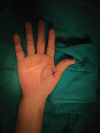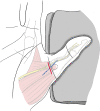Surgical Treatment for Trigger Thumb Using a Radial Approach
- PMID: 38152679
- PMCID: PMC10751200
- DOI: 10.1055/s-0042-1749421
Surgical Treatment for Trigger Thumb Using a Radial Approach
Abstract
The anatomy of the thumb flexor pulley system and surrounding structures differs from the fingers. The hand's positioning during trigger thumb release is troublesome. Iatrogenic radial digital nerve injuries of the thumb following opened or percutaneous A1 pulley release have been reported. We present the radial approach using a transverse incision for surgical release of the trigger thumb. This surgical approach aimed to restore a familiar surgical hand position, prevent radial digital nerve injury and bowstringing of the flexor pollicis longus, and decrease postoperative pain to facilitate recovery of hand function.
Keywords: A1 pulley release; radial approach; trigger thumb.
Society of Indian Hand Surgery & Microsurgeons. All rights reserved.
Conflict of interest statement
Conflict of Interest None declared.
Figures










Similar articles
-
Open Release of Pediatric Trigger Thumb.JBJS Essent Surg Tech. 2022 Apr 8;12(2):e21.00053. doi: 10.2106/JBJS.ST.21.00053. eCollection 2022 Apr-Jun. JBJS Essent Surg Tech. 2022. PMID: 36741041 Free PMC article.
-
Hand surface landmarks and measurements in the treatment of trigger thumb.J Hand Surg Am. 2013 Jun;38(6):1166-71. doi: 10.1016/j.jhsa.2013.02.028. Epub 2013 Apr 13. J Hand Surg Am. 2013. PMID: 23591023
-
Varied anatomy of the thumb pulley system: implications for successful trigger thumb release.J Hand Surg Am. 2012 Nov;37(11):2278-85. doi: 10.1016/j.jhsa.2012.08.005. J Hand Surg Am. 2012. PMID: 23101525
-
Rerouting extensor pollicis longus tendon transfer.J Hand Surg Am. 2015 Apr;40(4):822-5. doi: 10.1016/j.jhsa.2015.01.018. Epub 2015 Mar 5. J Hand Surg Am. 2015. PMID: 25746145 Review.
-
Trigger Finger: Adult and Pediatric Treatment Strategies.Orthop Clin North Am. 2015 Oct;46(4):561-9. doi: 10.1016/j.ocl.2015.06.014. Epub 2015 Aug 13. Orthop Clin North Am. 2015. PMID: 26410644 Review.
References
-
- Wolfe S W.TendinopathyIn: Wolfe SW, Hotchkiss RN, Pederson WC, Kozin SH, eds. Green's Operative Hand Surgery. 6th ed.Philadelphia: Elsevier Churchill Livingstone; 20112067–2088.
-
- Saldana M J. Trigger digits: diagnosis and treatment. J Am Acad Orthop Surg. 2001;9(04):246–252. - PubMed
-
- Kosiyatrakul A, Loketkrawee W, Luenam S. Different dosages of triamcinolone acetonide injection for the treatment of trigger finger and thumb: a randomized controlled trial. J Hand Surg Asian Pac Vol. 2018;23(02):163–169. - PubMed
-
- Ryzewicz M, Wolf J M. Trigger digits: principles, management, and complications. J Hand Surg Am. 2006;31(01):135–146. - PubMed
-
- Eastwood D M, Gupta K J, Johnson D P. Percutaneous release of the trigger finger: an office procedure. J Hand Surg Am. 1992;17(01):114–117. - PubMed
LinkOut - more resources
Full Text Sources
